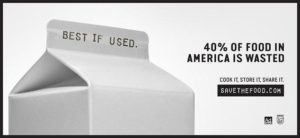In 1968, treasure hunters discovered a Civil War-era steamboat at the bottom of  the Missouri River. Among the items recovered were several intact cans of food. Six years later, scientists opened the cans to find perfectly edible peaches, oysters, and tomatoes. They had stayed unspoiled for over a century. So why do modern canned foods claim to expire in a matter of months?
the Missouri River. Among the items recovered were several intact cans of food. Six years later, scientists opened the cans to find perfectly edible peaches, oysters, and tomatoes. They had stayed unspoiled for over a century. So why do modern canned foods claim to expire in a matter of months?
Here’s the truth: Food expiration dates have nothing to do with safety, and are only loosely related to quality. They’re the manufacturer’s best estimate of when the product is at its freshest or “peak quality.” Many foods will still be good to eat days, weeks or months after those dates, depending on the food.
So, if you’ve been throwing food out on these dates, you’re not alone. According to one industry study, 90 percent of us occasionally throw away food too soon, and over half of us do it regularly. All due to a simple misunderstanding about package dates. Okay. If the expiration date doesn’t tell you when food goes bad, how do you know if it’s still good?
Let’s start with the difference between contamination and spoilage. Most of the microbes that spoil food are harmless for humans. In fact, some favorite foods and beverages, like yogurt, cheese, and wine, are made using controlled spoilage.
Contamination, however, is due to a pathogen — a microbe that can make us sick. It’s due to poor handling — like allowing food to come into contact with raw chicken — rather than keeping food around for too long. Contamination related to extended storage doesn’t really happen. The president of the Institute of Food Technologists once said, “In 40 years, in eight countries, if I think of major product recalls and food poisoning outbreaks, I can’t think of [one] that was driven by a shelf-life issue.”
Here’s how to sort out just what those dates mean:
Best before: mar 11 2016
These dates refer to quality rather than food safety. It’s the date before which the brand stands by its product (unless it’s been opened or left out in warm temperatures). Foods with a “best before” or “use by” date should be safe to eat after the date has passed, but they may no longer be at their very best. This is true for “best by,” “best if used by,” “enjoy by,” and other similar expressions.
Beware the danger zone
The main criterion for evaluating food safety is the amount of time food spends in the temperature “danger zone” (40 – 120 °F). If you leave food out on the counter or in a hot car, it could be unsafe even before the date on the package, regardless of what phrase you see.
Sell by June 22 2016
You can ignore these dates as they are meant for store staff. They actually build in quality so that if the food is sold by that date, you can still get it home and have top-quality shelf life for some time.
Use your eyes and nose
For the most part, you can trust your senses to know when food has gone bad. Milk, yogurt, juice, sauces—they can all be subject to the sniff or taste test. Even meat that looks a little faded or gray is okay to eat. The products to be careful with are those they tell pregnant women to avoid—like deli meats and unpasteurized dairy products—and anything with mold.
Freeze by:
One good way to extend the life of food beyond its date is to freeze it. It’s like pushing the pause button on your food. Almost anything can be frozen—meat, milk, cheese, eggs, bread, unused pasta sauce. (For a great guide on freezing foods, see this article from Good Housekeeping.)
Thanks to Save the Food.com for these great food waste facts.